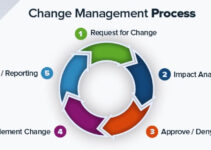Organizational change is the method of changing the system, structure, processes, and behavior of the organization. Disruptive market conditions and a competitive environment compel the organization to launch organizational changes to reach the company’s goals and objectives. Today, we’ll discuss the advantages and benefits of organizational change; along with its disadvantages.
Advantages & Benefits of Organizational Change
Some of the top advantages and benefits of organizational change are as follows;
Making Impact
When an organization launches any change initiative program, then it attracts the attention of the media and press because it would impact a lot of people significantly. It allows the company’s leadership and management an opportunity to clarify its vision and mission statement. While doing so, they also send a message to the market about value creation and responsiveness.
Reaffirming Values
Along with creating an impact in the market and achieving the company’s goals and objectives, the organizational change program also reaffirms the company’s core values. Every member of the organization would have a chance to revisit those core values and read them carefully. It reminds them that the company’s founders haven’t just decorated the wall with the mission statement; the company’s structure and actions also live up to it.
Rejuvenating Lie & Spirit
Static and rigid organizational structure doesn’t grow and last long. It is significant for businesses and organizations to evolve and be responsive over time to the changing market trends. In fact, the natural process of evolution also takes time and transforms itself. Many large multinational companies keep on transitioning from time to time in the form of innovation, creativity, divestiture, merger, and acquisition. They ask themselves this question every time whether they have achieved the right position or not.
Identifying Talent
Organizational change causes a lot of disruption in the company, and it compels them to do the unthinkable and do their best. It offers the opportunity to recognize key individuals with unique capabilities leading the change program at the forefront. In fact, such unique and talented team members and employees would come to the surface by themselves. Those who accept the change and focus on growth and development would become the future of tomorrow.
Putting Plans into Action
Envisioning the change is a very important part of the change program before implementing the change initiative. Often, businesses and organizations don’t realize and acknowledge the significance of envisioning. When they visualize it, it allows them to make their change initiative real and put it into action.
Boost Morale
If the change leaders effectively communicate the change program, then it would boost the morale and motivation level of employees. The notion of change initiative makes them feel excited that what the change would be like when it would become real. For instance, when a new manager replaces the old rigid-minded manager, then they would feel highly excited about it.
Promotes Innovation & Creativity
Businesses and organizations that accept the change, tend to promote a culture of innovation and creativity in their workplace. It is because the company’s managers, employees, supervisors, and top management are on the same page about the change program. In fact, they encourage them to approach the change in a creative manner whether its product or marketing strategy, and it goes a long way.
New Opportunities
A change initiative program is highly beneficial for those employees that accept the change. By embracing the change I mean that they would actively participate in training and development programs for the change. In fact, the company’s leadership would promote those employees that are performing well during the change program.
Upgrading Knowledge & Skills
The organizational change would compel employees and the workforce to get out of their comfort zone and upgrade their skills, knowledge, and expertise. They may not like it temporarily, but it would promote them in the long term.
Following Industry Trends
Organizational change allows businesses and companies to upgrade themselves relevant to industry trends and customer market preferences. When a company keeps on upgrading itself timely, it would help the company to stay ahead of the competition.
Disadvantages and Flaws of Organizational Change
After discussing the top benefits of organizational change; let’s discuss some of the key flaws and disadvantages of organizational change as follows;
Limited Efficiency
Employees have been habitual to the old system and methods, and the change to the new system would decrease efficiency and productivity. The change program across the organization would baffle their mind and they are wondering about the changes rather than focusing on their work. Ultimately, their efficiency and productivity at the workplace would decline significantly.
Declining Morale
If the organizational change initiative comprises of layoff of employees and managers, then it would decrease their morale and motivation level. Their confidence level would decline significantly, especially when they aren’t onboard about the change program. It can happen because of various reasons like limited communication, employees aren’t onboard, or dislikeness towards the new supervisor.
No Attachment
Organizational change results in the form of the recruitment of new employees and the layoff of some employees. The remaining employees would face the “no attachment” issue at the workplace with organizational culture and the new employees. They have lost their working colleagues and friends, and it would decline their productivity and output. An organization can’t afford to lose them because they’re a valuable member of the company, but their declining productivity would cost the company.
Uncertainty & Stress
Organizational change creates an atmosphere of risk, stress, fear, and uncertainty. If the company doesn’t implement the change program efficiently, then it would result in the form of loss of time, resources, and equipment.
Resistance
Employees won’t embrace the change easily and the management should be ready to face resistance from employees, especially if they aren’t on board with the change program. It is a completely normal human reaction to the change program because they’re habitual to the old methods of doing things, and the new methods baffle the mind. If the company doesn’t manage the resistance timely, then it would jeopardize the change initiative.
Costly
Launching the change program at the mass organization is highly expensive and it would cost the company a lot of money. Along with launching costs, there are some complementary costs attached to it like training and development cost, new technology, equipment, and various others.
High Failure Risk
According to an estimate, approximately 70% of the change programs fail because of various reasons like; limited communication, lack of clarity, employees not onboard, and conflicting interests. Before implementing the change program, then management should keep in mind all of these factors.
Causing Conflicts
If the company’s stakeholders, the management, and the change program have different goals and objectives, then it would cause conflicts among stakeholders about the change program. It would result in the form of conflicting interests, arguments, and disagreements. Ultimately, it would jeopardize the workplace environment.
Conclusion: Benefits of Organizational Change – Pros & Cons
After an in-depth study of the advantages and benefits of organizational change along with disadvantages; we have realized that change initiative could be highly beneficial to the organization. If you’re planning to implement the change program, then you should keep in mind its advantages and disadvantages relevant to your organization.
Ahsan is an accomplished researcher and has a deep insight in worldly life affairs. He goes Live 3 days a week on various social media platforms. Other than research writing, he’s a very interesting person.


